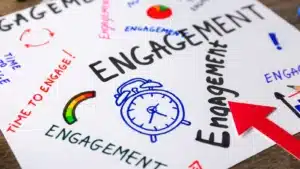
Creative Slideshow Ideas That Invite Participation and Questions
The world of presentations is evolving, and with it comes the need for innovative approaches that engage audiences and encourage participation. Gone are the days of one-way communication where the presenter speaks, and the audience listens passively. Today, effective presentations are dynamic dialogues that invite questions and foster interaction. This article explores creative slideshow ideas that not only capture attention but also invite audience participation and inquiries.
Understanding Your Audience
Before diving into creative slideshow ideas, it’s crucial to understand the audience. Knowing who they are, what they care about, and how they prefer to engage can significantly influence the effectiveness of a presentation. For instance, a sales manager like Jamie, who regularly presents to both internal teams and prospective clients, needs to ensure that her audience feels involved and valued. This understanding sets the foundation for a more interactive experience. By recognizing the diverse backgrounds and experiences of her audience, Jamie can tailor her content to resonate more deeply, making her presentations not just informative but also relatable and impactful.
Identify Audience Preferences
Consider conducting a quick survey before the presentation to gauge audience preferences. Are they more comfortable asking questions verbally, or do they prefer to submit them anonymously via text? Understanding these preferences can help tailor the presentation style and tools used, making it easier for attendees to engage. Additionally, it’s beneficial to analyze previous interactions or feedback from similar audiences. This data can provide insights into what topics sparked interest or what formats were most effective, allowing for a more refined approach that aligns with the audience’s expectations and needs.
Utilize Technology for Engagement
Incorporating technology can significantly enhance audience interaction. For example, using an AI-powered SMS engagement platform allows attendees to ask questions and receive answers in real-time without the need for apps or downloads. This frictionless approach encourages participation, especially among those who may hesitate to speak up in a traditional setting. Furthermore, integrating interactive elements such as live polls or quizzes can create a dynamic atmosphere, prompting attendees to think critically about the material being presented. These tools not only make the presentation more enjoyable but also provide valuable feedback to the presenter, allowing for adjustments on the fly to better meet the audience’s needs.
Moreover, leveraging social media platforms during the presentation can amplify engagement. Encouraging attendees to share their thoughts or insights on platforms like Twitter or LinkedIn using a specific hashtag can foster a sense of community and connection. This not only extends the conversation beyond the confines of the presentation but also allows for a broader audience to engage with the content, potentially attracting new followers or clients. By embracing these technological advancements, presenters can create a more immersive experience that resonates with their audience long after the slides have concluded.
Interactive Slideshow Formats
Choosing the right format for your slideshow can make a world of difference in how your audience engages with the content. Here are some creative ideas to consider:
Polls and Surveys
Integrating live polls or surveys into your presentation can instantly transform a passive audience into active participants. By asking questions related to the topic at hand, presenters can gauge audience understanding and adjust their delivery accordingly. For instance, Jamie could use a poll to ask her audience about their biggest challenges in adopting new technology, allowing her to tailor her message to address those specific pain points. Additionally, the results of these polls can be displayed in real-time, providing immediate feedback and fostering a sense of community among participants as they see their opinions reflected in the collective data.
Q&A Segments
Incorporating dedicated Q&A segments throughout the presentation, rather than saving all questions for the end, can create a more engaging atmosphere. This approach allows for immediate clarification and fosters a dynamic dialogue. AI-powered Q&A tools can facilitate this process by providing instant responses to audience questions, ensuring that no query goes unanswered. Furthermore, by encouraging questions throughout the presentation, presenters can identify areas where the audience may need more information or clarification, allowing for a more tailored and effective communication experience.
Interactive Case Studies
Presenting real-life case studies with interactive elements can keep the audience engaged. For example, Jamie could present a case study on a successful tech implementation, then invite the audience to brainstorm potential challenges and solutions. This collaborative approach not only encourages participation but also enriches the discussion with diverse perspectives. To enhance this format, Jamie could utilize breakout groups where smaller teams can discuss their ideas before sharing them with the larger audience, fostering a sense of teamwork and deeper engagement with the material. This method not only makes the case study more relatable but also allows participants to apply theoretical concepts to practical situations, enhancing their learning experience.
Visual Storytelling Techniques
Visual storytelling is a powerful tool in presentations. It helps to convey complex ideas in a relatable manner and keeps the audience’s attention. Here are some techniques to enhance visual storytelling:
Use of Infographics
Infographics can simplify data and make it more digestible for the audience. By presenting information visually, attendees are more likely to remember key points and engage in discussions. For instance, Jamie could use an infographic to illustrate the growth of her tech company over the years, sparking conversations about future goals and strategies. Infographics not only break down statistics but also combine visuals with narrative elements, allowing the audience to see trends and patterns at a glance. This can be particularly effective in fields like marketing or finance, where data-driven decisions are paramount. By integrating colors, icons, and charts, presenters can create a visually appealing narrative that resonates with the audience’s experiences and expectations.
Dynamic Slide Transitions
Utilizing dynamic slide transitions can keep the audience visually engaged. Instead of static slides, consider incorporating animations or transitions that highlight key points. This technique can help maintain interest and emphasize important information, making the presentation more memorable. For example, a subtle fade-in effect can draw attention to a new idea, while a slide that zooms in on a critical statistic can underscore its importance. However, it’s essential to strike a balance; excessive animations can be distracting. Therefore, presenters should choose transitions that complement the content rather than overshadow it, ensuring that the focus remains on the message being conveyed.
Story-Driven Content
Crafting the presentation around a compelling story can captivate the audience and encourage them to participate. By sharing relatable anecdotes or challenges faced in the industry, presenters can create an emotional connection with the audience. This connection often leads to more questions and discussions, enriching the overall experience. For instance, a presenter might share a personal story about overcoming a significant hurdle in their career, illustrating resilience and adaptability. Such narratives not only humanize the speaker but also provide a framework for the audience to relate their own experiences. Additionally, incorporating elements like character development and conflict resolution can transform a standard presentation into an engaging journey, making the audience eager to hear what comes next.
Encouraging Audience Interaction
Fostering an environment where audience interaction is encouraged is essential for a successful presentation. Here are some strategies to consider:
Anonymous Question Submission
Providing an option for anonymous question submission can encourage more audience members to participate. Many individuals may feel hesitant to ask questions in front of their peers, but anonymity can alleviate that fear. Using an SMS platform, attendees can submit questions throughout the presentation, ensuring that all voices are heard. This method not only promotes inclusivity but also allows for a diverse range of questions that might not surface in a traditional Q&A format. Additionally, presenters can compile these questions and address common themes, providing a comprehensive response that benefits the entire audience.
Interactive Activities
Incorporating interactive activities, such as small group discussions or brainstorming sessions, can enhance audience engagement. For example, Jamie could break her audience into small groups to discuss a specific challenge and then share their insights with the larger group. This collaborative approach not only invites participation but also fosters networking among attendees. Furthermore, by assigning roles within these groups, such as a note-taker or a spokesperson, participants can feel more invested in the discussion, leading to richer dialogue and more meaningful connections. This dynamic can transform a passive audience into active contributors, making the overall experience more memorable.
Real-Time Feedback
Encouraging real-time feedback during the presentation can help presenters adjust their content on the fly. By asking for audience input or reactions to specific points, presenters can create a more tailored experience. This approach not only keeps attendees engaged but also ensures that their needs and interests are being addressed throughout the presentation. Utilizing tools like live polling or instant feedback apps can facilitate this process, allowing presenters to gauge the audience’s understanding and interest levels instantly. Moreover, this immediate interaction can spark spontaneous discussions, leading to deeper insights and a more vibrant exchange of ideas, ultimately enriching the learning experience for everyone involved.
Leveraging Analytics for Future Presentations
After the presentation, analyzing audience engagement metrics can provide valuable insights for future improvements. Here’s how to leverage analytics effectively:
Tracking Engagement Metrics
Utilizing tools that track engagement metrics, such as conversation volume and participant demographics, can help presenters understand what resonated with their audience. For instance, if Jamie notices that certain topics generated more questions or discussions, she can prioritize those areas in future presentations. Additionally, analyzing the duration of audience attention through metrics like average view time can reveal which segments of the presentation were particularly captivating or where interest waned. This data not only aids in refining content but also in adjusting the pacing and delivery style to better match audience preferences.
Feedback Collection
Collecting feedback from attendees post-presentation can provide insights into what worked well and what could be improved. This feedback can be gathered through surveys or informal discussions, allowing presenters to refine their approach for future engagements. Moreover, incorporating open-ended questions in surveys can yield qualitative data that highlights specific areas for enhancement, such as clarity of information or the effectiveness of visual aids. Engaging with attendees on social media platforms post-event can also foster a sense of community and encourage ongoing dialogue, which can be invaluable for understanding audience sentiment.

Continuous Improvement
Using the insights gained from analytics and feedback, presenters can continuously improve their content and delivery. This iterative process ensures that each presentation becomes more effective, engaging, and relevant to the audience’s needs. Furthermore, by establishing a feedback loop, presenters can create a dynamic learning environment where they not only adapt their presentations but also share best practices with peers. This collaborative approach can lead to innovative presentation techniques and the development of new content that reflects the evolving interests and challenges faced by the audience. Embracing a mindset of continuous improvement not only enhances the quality of future presentations but also builds a stronger connection with the audience, fostering loyalty and engagement over time.
From Presentation to Conversation
Creating a presentation that invites participation and questions requires thoughtful planning and innovative approaches. By understanding the audience, utilizing technology, and incorporating interactive elements, presenters can transform their slideshows into engaging dialogues. Whether it’s through polls, real-time Q&A, or collaborative activities, the goal is to foster an environment where every attendee feels valued and heard. With the right tools and strategies, every presentation can become an opportunity for connection, engagement, and conversion.
For those looking to enhance their presentation experience, consider exploring AI-powered engagement platforms that simplify audience interaction and streamline follow-up processes. With features like real-time Q&A and automated lead capture, presenters can focus on delivering impactful messages while ensuring no question goes unanswered.
Unlock the Full Potential of Your Presentations with PresEngage
Ready to take your presentations to the next level? With PresEngage, you can harness the power of AI to create a truly interactive experience. Engage your audience with real-time SMS Q&A sessions, captivate their attention, and gather valuable CRM-ready data, all without the need for additional apps. Whether you’re a presenter, educator, trainer, or business professional, PresEngage is your partner in transforming every presentation into an opportunity for meaningful connection and conversion. Start for FREE today and revolutionize the way you engage with your audience.
Present Smarter. Engage Answer Convert Close Remarkably.
Dazzle your audience with Real-Time Q&A powered by your AI Co-Presenter.(Patent Pending)
PresEngage™ makes you look brilliant by connecting with everyone, instantly.
No Credit Card Required. 100% Risk Free.
Frictionless Audience Experience GUARANTEED.






